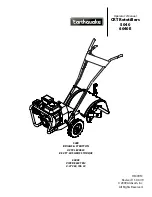
Operating instruction bladder accumulator BLAK - English
11
The operator of the system must be on receipt of the pressure equipment assume responsibility for
storage in accordance with these instructions. Lengthy periods in transport or storage whilst packaged
should be avoided.
5.4
Assembly / Commissioning
Setup / Installation
The assembly if the pressure equipment is to be carried out by qualified staff and must be specially
trained for this kind of work.
A vertical arrangement with the oil side at the bottom is recommended. Different arrangements are
likely to increase wear.
Use fastening gear designed to handle the static and dynamic forces. Ensure that the connected lines
are not under stress.
Use fastening hardware that is designed to handle the static and dynamic forces.
Welding or soldering on the pressure equipment or mechanical modification is prohibited. No
additional forces or moments are allowed to impact on the pressure equipment. The pressure
equipment must not be exposed to flames or electrical / magnetic fields that may heat the equipment.
Ensure that the pressure equipment enclosure will not be deformed or otherwise damaged when fitting
the consoles / clamp.
Extensive damage may cause the pressure equipment to explode.
Do not install and operate the pressure equipment in rooms that are unprotected
against lightning and earthquakes.
Depending on operation, surface temperatures capable of causing burns may occur at the
limits of operating conditions. The operator should provide suitable protection.
Consult Chapter 6 for service notes and test schedules.
Use the fastening hardware provided by the manufacturer to ensure that all parts will be securely
fastened.
Before assembly:
•
Check the delivery for transport damage to ensure that it is technically intact.
•
Instruct the qualified staff.
Prior to commissioning, the operator should:
•
Check the technical documentation for completeness as per Chapter 5.1.
•
Completion of the infeed and outfeed systems and the parts of the system into which the
pressure equipment will be incorporated that have a safety functionality.
•
Ensuring the functionality of installed instrumentation.
The operator should have the entire system acceptance tested (see Chapter 3.5) before
commissioning the pressure equipment. Adjust the pre-inflation pressure (P
0
) to match the
operating parameters (see Chapter 2.2). The pressure equipment will be delivered with a
transport / storage pressure of 2 to 5 bar or to customer requirements.
Observe Chapters 2 and 4 when filling or draining.
Uninstalling the pressure equipment
Measure and ensure that the oil and gas sides are depressurised before uninstalling. Remove all parts
fitted on the fluid side, such as reducers, screwed connections, accessories, etc.
Never open the bleed screw, when the hydraulic circuit to which the accumulator is
connected, is under pressure.
The fluids valve should now be open or easy to open by hand when the pressure equipment
is not under pressure. Strictly stop work if this is not the case and obtain technical advice
from the manufacturer.






































